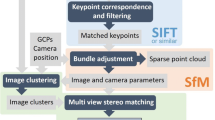Abstract
We analyzed the relationship between resolution and predictability and found that while increasing resolution provides more descriptive information about the patterns in data, it also increases the difficulty of accurately modeling those patterns. There are limits to the predictability of natural phenomenon at particular resolutions, and “fractal-like” rules determine how both “data” and “model” predictability change with resolution.
We analyzed land use data by resampling map data sets at several different spatial resolutions and measuring predictability at each. Spatial auto-predictability (Pa) is the reduction in uncertainty about the state of a pixel in a scene given knowledge of the state of adjacent pixels in that scene, and spatial cross-predictability (Pc) is the reduction in uncertainty about the state of a pixel in a scene given knowledge of the state of corresponding pixels in other scenes. Pa is a measure of the internal pattern in the data while Pc is a measure of the ability of some other “model” to represent that pattern. We found a strong linear relationship between the log of Pa and the log of resolution (measured as the number of pixels per square kilometer). This fractal-like characteristic of “self-similarity” with decreasing resolution implies that predictability may be best described using a unitless dimension that summarizes how it changes with resolution. While Pa generally increases with increasing resolution (because more information is being included), Pc generally falls or remains stable (because it is easier to model aggregate results than fine grain ones). Thus one can define an “optimal” resolution for a particular modeling problem that balances the benefit in terms of increasing data predictability (Pa) as one increases resolution, with the cost of decreasing model predictability (Pc).
Similar content being viewed by others
References
Colwell, R.K. 1974. Predictability, constancy, and contingency of periodic phenomena. Ecology 55: 1148–1153.
Costanza, R. 1975. The spatial distribution of land use sub-systems, incoming energy and energy use in South Florida from 1900 to 1973. aMaster's Research Project. Department of Architecture, University of Florida, Gainesville, FL. 204 pp.
Costanza, R. 1979. Embodied energy basis for economic-ecologic systems. Ph.D. Dissertation. University of Florida, Gainesville, FL. 254 pp.
Costanza, R. and Maxwell, T. 1991. Spatial ecosystem modeling using parallel processors. Ecological Modeling 58: 159–183.
Costanza, R. and Sklar, F.H. 1985. Articulation, accuracy, and effectiveness of mathematical models: a review of freshwater wetland applications. Ecological Modeling 27: 45–68.
Costanza, R., Sklar, F.H. and White, M.L. 1990. Modeling coastal landscape dynamics. BioScience 40: 91–107.
Mandelbrot, B.B. 1977. Fractals. Form, chance and dimension. W.H. Freeman and Co., San Francisco, C.A.
Mandelbrot, B.B. 1983. The Fractal Geometry of Nature. W.H. Freeman and Co., San Francisco, CA.
Milne, B.T. 1988. Measuring the fractal dimension of landscapes. Applied Mathematics and Computation 27: 67–79.
Olsen, L.F. and Schaffer, W.M. 1990. Chaos versus noisy periodicity: alternative hypotheses for childhood epidemics. Science 249: 499–504.
Sugihara, G. and May, R.M. 1990. Nonlinear forecasting as a way of distinguishing chaos from measurement error in time series. Nature 344: 734–741.
Turner, M.G. 1987. Spatial simulation of landscape changes in Georgia: a comparison of 3 transition models. Landscape Ecology 1: 29–36.
Turner, M.G., Costanza, R. and Sklar, F.H. 1989. Methods to Compare Spatial Patterns for Landscape Modeling and Analysis. Ecological Modelling 48: 1–18.
Author information
Authors and Affiliations
Rights and permissions
About this article
Cite this article
Costanza, R., Maxwell, T. Resolution and predictability: An approach to the scaling problem. Landscape Ecol 9, 47–57 (1994). https://doi.org/10.1007/BF00135078
Issue Date:
DOI: https://doi.org/10.1007/BF00135078




